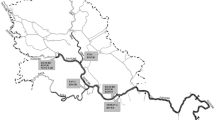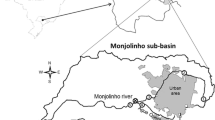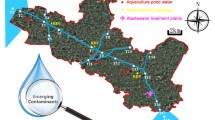Abstract
Contaminants of emerging concern (CECs), including pharmaceuticals, artificial sweeteners, steroid hormones, and current-use pesticides have been detected in surface waters around the world, but to date, there have been no reports in the peer-reviewed literature on the levels of these classes of contaminants in freshwater resources in the Caribbean region. In the present study, multi-residue solid phase extraction (SPE) and liquid chromatography with tandem mass spectroscopy (LC-MS/MS) were used to analyze grab samples of surface waters collected from five different watersheds in Barbados, West Indies. The artificial sweeteners (AS), acesulfame, cyclamate, saccharin, and sucralose were widely detected in the watersheds, indicating contamination from domestic wastewater, and the concentrations of these chemical tracers in water were correlated with the concentrations of the non-prescription pharmaceutical, ibuprofen (R 2 values of 0.4–0.6). Surprisingly, the concentrations of another chemical tracer of domestic wastewater, caffeine were not correlated with ibuprofen or AS concentrations. Several other prescription pharmaceuticals and the steroid hormones, estrone and androstenedione, were detected in selected watersheds at low ng/L concentrations. The fungicide, chlorothalonil was widely detected in surface waters at low (< 10 ng/L) concentrations, but the levels of this pesticide were not correlated with the concentrations of the other target analytes, indicating that the source of this pesticide is not domestic wastewater. An informal survey of disposal practices for out of date or unused drugs by pharmacies in Barbados indicated that disposal into trash destined for the landfill and flushing down the sink might be significant sources of contamination of water resources by pharmaceuticals.





Similar content being viewed by others
References
Avisar, D., Lester, Y., & Ronen, D. (2009). Sulfamethoxazole contamination of a deep phreatic aquifer. Science of the Total Environment, 407, 4278–4282.
Bahussain, E., Waheedi, M., & Koshy, S. (2012). Practice, awareness and opinion of pharmacists toward disposal of unwanted medications in Kuwait. Saudi Pharmaceutical Journal, 20, 195–201.
Baker, D. R., & Kasprzyk-Hordern, B. (2013). Spatial and temporal occurrence of pharmaceuticals and illicit drugs in the aqueous environment and during wastewater treatment: New developments. Science of the Total Environment, 255, 442–456.
Bendz, D., Paxéus, N. A., Ginn, T. R., & Loge, F. J. (2005). Occurrence and fate of pharmaceutically active compounds in the environment, a case study: Hoje River in Sweden. Journal of Hazardous Materials, 122, 195–204.
Bound, J. P., & Voulvoulis, N. (2005). Household disposal of pharmaceuticals as a pathway for aquatic contamination in the United Kingdom. Evironmental Health Perspective, 13, 1706–1711.
Buerge, I. J., Poiger, T., Müller, M. D., & Buser, H. R. (2006). Combined sewer overflow to surface waters detected by anthropogenic marker caffeine. Environmental Science & Technology, 40, 4096–4102.
Cashman, A., Nurse, L., & John, C. (2010). Climate change in the Caribbean: The water management implications. Journal of Environment & Development, 19, 42–67.
Du, B., Price, A. E., Scott, C. W., Kristofco, L. A., Ramirez, A. J., Chambliss, C. K., Yelderman, J. C., & Brooks, B. W. (2014). Comparison of contaminants of emerging concern removal, discharge and water quality hazards among centralized and on-site wastewater treatment systems receiving common wastewater influent. Science of the Total Environment, 466–467, 976–984.
Edwards, Q. A., Kulikov, K. M., & Garner-O’Neale, L. D. (2015). Caffeine in surface and wastewaters in Barbados, West Indies. SpringerPlus, 4, 1–12.
Johnson, A. C., Belfroid, A., & Di Corcia, A. (2000). Estimating steroid oestrogen inputs into activated sludge treatment works and observations on their removal from the effluent. Science of the Total Environment, 256, 163–173.
Jones, I. C., & Banner, J. L. (2003). Estimating recharge thresholds in tropical karst island aquifers: Barbados, Puerto Rico and Guam. Journal of Hydrology, 278, 131–143.
King, K. W., & Balogh, J. C. (2010). Chlorothalonil and 2,4-D losses in surface water discharge from a managed turf watershed. Journal of Environmental Monitoring, 12, 1601–1612.
Kolodziej, E. P., Harter, T., & Sedlak, D. L. (2004). Dairy wastewater, aquaculture, and spawning fish as sources of steroid hormones in the aquatic environment. Environmental Science & Technology, 38, 6377–6384.
Lange, F. T., Scheurer, M., & Brauch, H. J. (2012). Artificial sweeteners - a recently recognized class of emerging environmental contaminants: A review. Analytical and Bioanalytical Chemistry, 403(9), 2503–2518.
Li, H., Helm, P., & Metcalfe, C. (2010). Sampling in the Great Lakes for pharmaceuticals, personal care products, and endocrine disrupting substances using the passive polar organic chemical integrative sampler. Environmental Toxicology and Chemistry, 29, 751–762.
Luo, Y., Guo, W., Ngo, H. H., Nghiem, L. D., Hai, F. I., Zhang, J., Liang, S., & Wang, X. C. (2014). A review on the occurrence of micropollutants in the aquatic environment and their fate and removal during wastewater treatment. Science of the Total Environment, 473–474, 619–641.
Martín, J., Camacho-Muñoz, D., Santos, J. L., Aparicio, I., & Alonso, E. (2012). Occurrence of pharmaceutical compounds in wastewater and sludge from wastewater treatment plants: Removal and ecotoxicological impact of wastewater discharges and sludge disposal. Journal of Hazardous Materials, 240, 40–47.
Mawhinney, D. B., Young, R. B., Vanderford, B. J., Borch, T., & Snyder, S. A. (2011). Artificial sweetener sucralose in U.S. drinking water systems. Environmental Science & Technology, 45, 8716–8722.
Metcalfe, C. D., Beddows, P. A., Gold, G., Bouchot, T. L., Metcalfe, C. D., Li, H., & Van Lavieren, H. (2011). Contaminants in coastal karst aquifer systems along the Caribbean coast of the Yucatan peninsula, Mexico. Environmental Pollution, 159, 991–997.
Metcalfe, C. D., Hoque, M. E., Sultana, T., Murray, C., Helm, P. A., & Kleywegt, S. (2014). Monitoring for contaminants of emerging concern in drinking water using POCIS passive samplers. Environmental Science: Processes & Impacts, 16, 473–481.
Metcalfe, C. D., Sultana, T., Li, H., & Helm, P. A. (2016). Current-use pesticides in urban receiving waters in Ontario, Canada monitored using polar organic chemical integrative passive samplers. Journal of Great Lakes Research, 42, 1432–1442.
Miao, X.-S., & Metcalfe, C. D. (2003). Determination of cholesterol-lowering statin drugs in aqueous samples using electrospray liquid chromatography-tandem mass spectrometry. Journal of Chromatography A, 998, 133–141.
Monteiro, S. C., & Boxall, A. B. (2010). Occurrence and fate of human pharmaceuticals in the environment. Reviews of Environmental Contamination and Toxicology, 202, 53–154.
Niquille, A., & Bugnon, O. (2008). Pharmaceuticals and environment: Role of community pharmacies. In K. Kümmerer (Ed.), Pharmaceuticals in the Environment (pp. 467–473). Heidelberg: Springer.
Nurse, L., Cashman, A., & Mwansa, J. (2012). Confronting the challenges of sewerage management in the Caribbean: A case study from the island of Barbados. Environment, 54, 30–43.
Peeler, K. A., Opsahl, S. P., & Chanton, J. P. (2006). Tracking anthropogenic inputs using caffeine, indicator bacteria, and nutrients in rural freshwater and urban marine systems. Environmental Science & Technology, 40, 7616–7622.
Ryan, C. C., Tan, D. T., & Arnold, W. A. (2011). Direct and indirect photolysis of sulfamethoxazole and trimethoprim in wastewater treatment plant effluent. Water Research, 45, 1280–1286.
Sangchan, W., Hugenschmidt, C., Ingwersen, J., Schwadorf, K., Thavornyutikarn, P., Pansombat, K., & Streck, T. (2012). Short-term dynamics of pesticide concentrations and loads in a river of an agricultural watershed in the outer tropics. Agriculture, Ecosystems & Environment, 158, 1–11.
Schuerer, M., Brauch, H. J., & Lange, T. (2009). Analysis and occurrence of seven artificial sweeteners in German waste water and surface water and in soil aquifer treatment (SAT). Analytical and Bioanalytical Chemistry, 394, 1585–1594.
Scribner, E. A., Orlando, J. L., Battaglin, W. A., Sandstrom, M.W., Kuivila, K. M., Meyer, M. T. (2006). Results of analyses of the fungicide, chlorothalonil, its degradation products, and other selected pesticides at 22 surface-water sites in five southern states, 2003–04. U.S. Geological Survey, Open File Report 2006–1207, 36 p.
Seehuven, D. A., & Edwards, J. (2006). Patient practices and beliefs concerning disposal of medications. Journal of American Board of Family Medicine, 19, 542–547.
Tollefsen, K. E., Nizzetto, L., & Huggett, D. B. (2012). Presence, fate and effects of the intense sweetener sucralose in the aquatic environment. Science of the Total Environment, 438, 510–516.
Tosic, M., Bonnell, R. B., Dutilleul, P., & Oxenford, H. A. (2008). Runoff water quality, land use and environmental impacts on the Bellairs Fringing Reef, Barbados. In X. Yang (Ed.), Remote Sensing and Geospatial Technologies for Coastal Ecosystem Assessment and Management (pp. 521–553). Berlin: Springer-Verlag.
Trenholm, R. A., Vanderford, B. J., Holady, J. C., Rexing, D. J., & Snyder, S. A. (2006). Broad range analysis of endocrine disruptors and pharmaceuticals using gas chromatography and liquid chromatography tandem mass spectrometry. Chemosphere, 65, 1990–1998.
UNEP. (2004). Global International Water Assessment (GIWA) Caribbean Sea/Small Islands, GIWA Regional Assessment 3a, Global Environment Facility (GEF) and Högskola, Kalmar, Sweden.
Van Stempvoort, D. R., Roy, J. W., Brown, S. J., & Bickerton, G. (2011). Artificial sweeteners as potential tracers in groundwater in urban environments. Journal of Hydrology, 401, 126–133.
Verlicchi, P., Al Aukidy, M., & Zambello, E. (2012). Occurrence of pharmaceutical compounds in urban wastewater: Removal, mass load and environmental risk after a secondary treatment - a review. Science of the Total Environment, 429, 123–155.
Vulliet, E., & Cren-Olivé, C. (2011). Screening of pharmaceuticals and hormones at the regional scale, in surface and groundwaters intended to human consumption. Environmental Pollution, 159, 2929–2934.
Wood, B. P., Gumbs, F., & Headley, J. V. (2002). Distribution and occurrence of atrazine, deethylatrazine and ametryne residues in groundwater of the tropical island Barbados. Communications in Soil Science and Plant Analysis, 33, 3501–3515.
Wu, L., Liu, G., Yates, M. V., Green, R. L., Pacheco, P., Gan, J., & Yates, S. R. (2002). Environmental fate of metalaxyl and chlorothalonil applied to a bentgrass putting green under southern California climatic conditions. Pest Management Science, 58, 335–342.
Xing, Z., Chow, L., Cook, A., Benoy, G., Rees, H., Ernst, B., Meng, F., Li, S., Zha, T., Murphy, C., Batchelor, S., & Hewitt, L. M. (2012). Pesticide application and detection in variable agricultural intensity watersheds and their river systems in the maritime region of Canada. Archives of Environmental Contamination and Toxicology, 63, 471–483.
Young, T. A., Heidler, J., Matos-Pérez, C. R., Sapkota, A., Toler, T., Gibson, K. E., Schwab, K. J., & Halden, R. U. (2008). Ab initio and in situ comparison of caffeine, triclosan, and triclocarban as indicators of sewage-derived microbes in surface waters. Environmental Science & Technology, 42, 3335–3340.
Acknowledgements
Quincy Edwards received financial support from the Emerging Leaders in the Americas Program (ELAP) of the Government of Canada, as well as a Graduate Student Research Award from the University of the West Indies, Cave Hill Campus. The funding agencies played no role in the writing or interpretation of the manuscript. Water sampling was assisted by the Barbados Water Authority and the Environmental Protection Department, more specifically Mr. Gregory Thompson and Mr. Anthony Headley. The extraction of contaminants was made possible through the guidance of Brenda Seaborn in the lab of C. Metcalfe. All analyses were conducted at the Water Quality Centre at Trent University, Ontario, Canada.
Author information
Authors and Affiliations
Contributions
All five authors (QE, SK, LG, CM, and TS) were equally involved in the design and execution of the conducted research (project conception, research planning, laboratory experimentation, data collection, and data analysis). The authors were significantly involved in statistical analysis, manuscript drafting and editing. Moreover, all five authors have given final approval of the manuscript and acknowledge their accountability of the contents of the paper.
Corresponding authors
Ethics declarations
Competing interests
The authors declare that they have no competing interests.
Rights and permissions
About this article
Cite this article
Edwards, Q.A., Kulikov, S.M., Garner-O’Neale, L.D. et al. Contaminants of emerging concern in surface waters in Barbados, West Indies. Environ Monit Assess 189, 636 (2017). https://doi.org/10.1007/s10661-017-6341-4
Received:
Accepted:
Published:
DOI: https://doi.org/10.1007/s10661-017-6341-4





